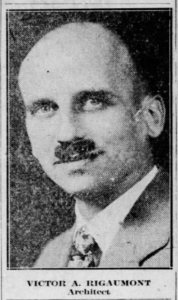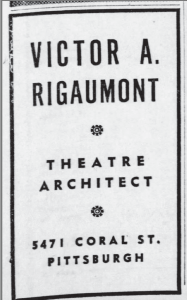SMITH HISTORY BLOG: Victor Rigaumont, Architect
by Chris Woodworth
The Smith Opera House re-opened as Schine’s Geneva Theatre in March 1931. Audiences in the theatre that night were enveloped by the atmospheric theatre design that placed them under a starry night sky in a “Moorish Courtyard.” The architect responsible for that design was Victor A. Rigaumont, a Pittsburgh-based theatre and church designer. The Smith was not the first area theatre designed by Rigaumont, who was also responsible for the transformation of Ithaca’s State Theatre (“New Theater” 16). Little is known about Rigaumont but correspondence between him, Morrell Vrooman, the engineer and construction manager, Henry H. Lenz, the on-site representative of Vrooman, C.C. Young, the manager of The Smith, and various representatives of Schine Enterprises in Gloversville, NY, reveals that the process of renovating The Smith was, at times, somewhat fraught.
At first glance, the correspondence seems fairly innocuous, noting adjustments to the design and the ripple effects in terms of shifting costs of materials and labor and modifications to the timeline. However, some of the correspondence reveals the unusual challenges presented by the renovation, particularly in working with Rigaumont. On October 16, 1930 Henry H. Lenz, writing to Rigaumont on behalf of Morrell Vrooman, Inc., claims,
“This situation in Geneva, as you know, is very bad. Instead of improving it is going in the opposite direction. The job is behind schedule, you have failed to give sufficient information to the contractor, you have failed to even answer his correspondence, you give the job no personal attention in Geneva, you assume the role of dictator and expect foolish orders to be obeyed, you have failed to keep the owners part of the contract, you have caused unnecessary delays in the work which will cost both owner and contractor considerable more money, you have required us to do much more office work than would be required of an architect of good business judgement, you have generally messed up the whole job.”

Photograph of Victor Rigaumont, Architect, from Ithaca Journal article about the creation of the State Theatre in Ithaca, Dec. 5, 1928.
A meeting was held on October 24, 1930 at the Regent Theatre (another one of the Schine’s facilities in Geneva) to address some of these concerns. In addition to Lenz and Rigaumont, C.C. Young (the Smith’s manager) and Mr. J.M Schine himself were present. The transcript of the meeting reveals a tense series of exchanges. This meeting does not seem to have fully resolved the various issues leading to construction delays, however. In a letter on his lawyer’s letterhead, dated October 25, 1930, Rigaumont contends that delays in the renovation timeline are due to “two reasons. First, lack of proper superintendence [on the part of Morrell Vrooman]. Second, the contractor has not provided a sufficient number of workmen and materials necessary to carry on the operation with progress required in order to complete it within the time specified in the schedule furnished.” Yet the contractor asserts that Rigaumont caused delays. For example, in a memo from Morrell Vrooman, the engineer and construction manager, dated November 17, 1930, Vrooman lists a number of errors in Rigaumont’s latest revision of the architectural plans. Some of the especially eye-popping errors on the 33-item list include: “7. No design of balcony stairs. […] 19. No roof called for in plans and specifications. […] 24. Coal bin entrance about 3 feet high. Coal bin too small—man would have to crawl on hands and knees to get part of coal out.”
Schine’s Geneva Theatre was originally slated to open in January 1931. The various delays and interpersonal tensions resulted in a March 1931 opening. As the authors of the Historic Structure report note that for Rigaumont, “the Schine Geneva Theatre was his last commission for [Schine Enterprises] and it was his last major work of note in the records.”
Works Cited
Ad for Victor A. Rigaumont, Theatre Architect. The Pittsburgh Press, 21 Feb. 1937, pp. 27.
Correspondence between Victor Rigaumont, Morrell Vrooman, Henry H. Lenz, C.C. Young, Schine Enterprises of Gloversville, and other pertinent parties. Smith Opera House Archives.
Crawford and Stearns Architects and Preservation Planners. “Historic Structure Report: Smith Opera House.” Syracuse NY, Jan 1990.
“New Theater Was Designed by Rigaumont.” Ithaca Journal, 5 Dec. 1928, pp. 16.
Would you like to be involved in creating Celebrate The Smith: An Immersive Theatre Event, The Smith’s 125th Birthday Celebration? We need actors, directors, writers, stage managers, and hosts. No theatre experience needed!
Prefer to join us as an audience member? Click here for tickets and information.
